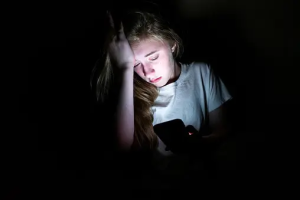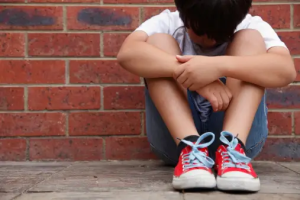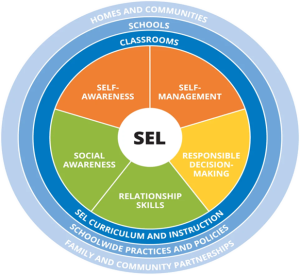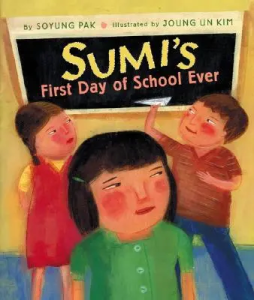12 Bullying and School-Age Children
Dr. Rachel Stewart and Olivia Nelson
*Trigger Warning: Bullying, suicide*
Introduction
Throughout this chapter, bullying will be discussed from a variety of angles. Bullying will be addressed through types of bullying, at-risk children, the impact of bullying, proactive vs. reactionary approaches, the social and emotional learning (SEL) approach, and using books as a resource to aid in discussions. Before reading through this chapter, think about the knowledge you have on bullying and how it may affect school-age children. Is bullying something important to consider when working with school-age children? What is your bias regarding bullying and school-age children? Make a list of everything that comes to mind when you think of bullying and when you finish this chapter, revisit that list to see how your thinking may have changed.
Types of Bullying
There are four types of bullying that need to be considered to fully understand what school-age children are currently facing. The four types are:
- Verbal Bullying: This is the use of words to put down or insult another person.
- Physical Bullying: This is physical aggression with the intent to harm another person or their belongings.
- Emotional Bullying (Passive Bullying): This bullying can be seen as indirect towards the victim as it involves behaviors such as, spreading lies or rumours (gossiping). Emotional bullying is most associated with relational aggression. Relational aggression is bullying that affects a victim’s self-esteem through emotional bullying. This is most seen in females during school-age and can cause long-lasting damage to the victim. It is common for victims to not disclose when this is happening due to fear of negative consequences (Jones et al., 2020). Due to decreased self-esteem in school-age, particularly among females, females are more susceptible to bullying (Hartas et al., 2024).
- Cyberbullying: This form of bullying is purely online through social media, messages, or websites. Cyberbullying often is accompanied by verbal, physical, and/or emotional bullying.

Cyberbullying
All forms of bullying are equally important to understand and intervene. However, cyberbullying creates a new danger as the child will go home and still experience the bullying. This makes all the child’s social environments equally unsafe. The child is unable to get away from the aggressor. Cyber bullying can happen through any sort of electronic connection. This can include gaming systems, phones, or computers. According to Losiak-Pilch (et al., 2022) cyberbullying can appear in any of the following seven ways:
- Exclusion: This can look like purposefully leaving another person out in an online group.
- Cyberstalking: This can look like fixation on another person’s movements online with aggressive online communications towards said person.
- Cyber Harassment: This is repeated upsetting communications towards another person.
- Flaming: This is an emotionally charged exchange between two or more individuals.
- Denigration: This is when a person spreads lies about another person online.
- Impersonation: This is when a person pretends to be the victim through online accounts and then bullies other people as that person’s online persona.
- Outing and Trickery: This is sharing of information about another person that is usually embarrassing or personal to others online.
The latter forms of cyberbullying can be seen alone or as a combination.
Vulnerable Children
Before delving into the children that are most vulnerable to bully and be bullied, it is important to remember that every child could bully and be victimized. The following information is reflecting frequency of bullying and victimization but should not disregard anything seen or made aware of while working with children.
The most vulnerable children to be victimized fall under the category of rejected-withdrawn, as discussed in earlier chapters. A multitude of factors have been seen to make a child more vulnerable to bullying. These factors are low socioeconomic status, LGBTQ+ children, race, and disabilities (Hong et al., 2020). The most common bullies are seen to be popular-antisocial, rejected-aggressive, and rejected as discussed in earlier chapters.
The Impact of Bullying
The impact of bullying can cause life-long trauma and at times, become fatal for the child experiencing it. There is a direct correlation between a child’s ability to practice emotional regulation and being the victim of bullying to suicidal behaviors (Brausch et al., 2024). The most common diagnosis associated with bullying is post-traumatic stress disorder (PTSD) (Dyregrov et al., 2020). Cyberbullying victims are reported to have the most amount of PTSD symptoms in comparison to the other forms of bullying (Baldry et al., 2019). The symptoms of PTSD are isolation, reoccurring upsetting thoughts regarding the bullying, nightmares, reliving the bullying, general upset, heart palpitations, upset stomach, irritability, insomnia, being on high alert, and/or anger (Baldry et al., 2019).

When being victimized at school it is more likely for a child to be absent from school (Inoue et al., 2024). This is taking away from a child’s access to education and should be especially considered. The following vulnerable children need to be considered as the risk of being victimized is higher. Children with a lower socioeconomic status who experience bullying are more likely to have physical side effects such as, headaches, stomach aches and/or backpain (Holstein et al., 2023). Children who identify as LGBTQ+ are at a higher risk of self-harm, suicidal ideation, and suicide attempts (Bower-Brown et al., 2021).
It is important to acknowledge that the act of bullying also causes stress to the bully. Bullies are reported as having a higher amount of stress (Baldry et al., 2019). This stress can appear in symptoms correlated with PTSD. By participating in bullying, a child is more likely to show symptoms of being severely distressed (Mark et al., 2019). In accordance with the study that found this, the attributes of a child being severely distressed are poor mental well-being and hopelessness (Mark et al., 2019). These attributes are linked to depression and likewise, need to be addressed (Mark et al., 2019).
Proactive vs. Reactionary Approaches
Proactive approaches prevent bullying before it has happened. Proactive approaches, also known as intervention approaches, help to avoid the trauma caused by bullying completely. Later in the chapter, the social and emotional learning (SEL) approach will be discussed as the best technique to stop bullying from occurring. Briefly, the SEL approach addresses a child’s social and emotional skills, which in turn supports an environment that builds on empathy, healthy relationships, emotional regulation, and self-esteem. Often, bullies in schools fall into one of the following three categories: popular-antisocial, rejected-aggressive, and rejected. Victims of bullying regularly are seen to be rejected-withdrawn. Children who are rejected-withdrawn tend to have low self-esteem which makes them more susceptible to bullying. Through classroom and school settings, self-esteem among school-age children can be developed and bullying can be reduced (El Sayed et al., 2022). SEL gives a child the skills to avoid popular-antisocial, rejected-aggressive, and rejected behaviors while empowering children who show rejected-withdrawn behaviors.
Watch this clip below and make note of what you see and feel. Do you feel as though the vice principal effectively handled the situation?
Video Transcript
Principal
You all right, Cole, I’m in the middle of this. You just go, okay, Cole, stay right here, right here. I’m gonna ask you guys to shake hands. Can you do that?
Bully
Yeah,
Principal
shake hands. Cole, Cole, you are not going anywhere. He is offering his hand and let this drop. You may go Cole, I expected more
Cole
because I criticized me every single day, then why are you around him? I don’t he comes to me. I finally get away from him. He follows me, and he criticized me, calling me, calling me a, p, U, S, S, Y,
Principal
okay, honey, that’s not right, and he shouldn’t do that. I don’t even know you know what he was trying to say. He was sorry.
Cole
He already did, and he didn’t mean it on you
Principal
didn’t mean it when you stuck your hand out, either. So that means you’re just like him. Right? What you don’t like in him? Hurt people by not shaking his hand. You’re just like him.
Cole
Someone who pushes you into a wall threatens to break your arm, threatens to stab you and kill you. He
Principal
apologized. And have you reported all that sort of stuff? Yes. Okay, then it’s been taken care
Cole
of. And all of them said, even the cops said, told him to stay away from me. Okay, he doesn’t All right.
Principal
Can you try to get along? I think you guys might be really good friends At some time we
Cole
were and they started Bullying school.
Crowd
Two people do a seat dumbass
Alex
and they punch you in the jaw, strangle me and knock things out of my hand, take things from me, sit on me.
Alex
Wish me so far that I Want to become the bully.
Reactionary approaches confront the bullying after it has already happened. So in other words, the damage has already been done. Reactionary responses to bullying often involve an unrelated consequence which includes suspensions, expulsions, detentions, etc. These consequences remove the child from the opportunity to experience empathy. Bullies are generally antisocial in character and therefore lack empathy. A child who lacks empathy will struggle to overcome this constraint without being introduced to opportunities in which this child can experience it. Reactionary strategies are a cycle that unfortunately perpetuates through educational environments. Through inductive and deductive reasoning (see cognitive development), a child will determine that they must deal with the bullying by themselves. For example, a child experiencing bullying will go to the educator with the understanding that by doing this, the bullying will end. When a child continually goes back to the educator and there is no change, the child will stop going to them for help. The child has now experienced a change of understanding concerning how to address their bullying situation. When the educational system continues to approach bullying in a reactionary way, the bullying is maintained and often worsens.
Looking back at the above video clip, think about how the vice principal approached the situation. Was this a proactive or reactionary approach? What made it a proactive or reactionary approach?
The SEL Approach
The most effective proactive approach to eradicating bullying is social and emotional learning (SEL). SEL focuses on supporting a child’s growth in skills that fall under social and emotional development. By strengthening our social and emotional skills through SEL a child can form a healthy identity, practice emotional regulation, set and achieve goals, participate in healthy relationships, have empathy, and make appropriate decisions (CASEL, 2020).
To further understand the areas in which SEL covers, a framework created by CASEL exhibits the five core competencies of SEL (2020). This wheel below gives visual representation of the competencies.

- Self-Awareness: The ability to identify emotions. This can be practiced through reflection, journaling, mediation, etc.
- Self-Management: The ability to self-motivate, manage emotions, and practice self-control. This can be practiced through mindfulness exercises and building tools to deal with anger.
- Social Awareness: The ability to embrace diversity and understand one’s impact on the environment around them. This can be practiced through role playing, ethical exercises, etc.
- Relationship Skills: This is the ability to work cooperatively, participate in conflict resolution, and build healthy relationships.
- Responsible Decision-Making: This is the ability to consider self and others while making decisions and problem solving.
For SEL to get the best results, all five core competencies should be considered when working with school-age children. The five core competencies are essential skills that can be applied as an intervention to the school system. Social and emotional skill development can be introduced into classrooms through instructional education on the competencies, cooperative learning practices, project-based learning practices, and the reflection of SEL in curriculum and pedagogy (CASEL, 2020). When SEL is integrated properly, significant improvement for children in kindergarten classrooms showed an increase in all five SEL competencies (Cristescu et al., 2022). Cristescu et al. state that, “emotional competence, reduced risk of emotional, and behavioral problems, as well as with emerging evidence of positive effects on executive functions or school readiness” (2022). By starting in kindergarten with an SEL approach, children are given the opportunity to succeed in social environments. With a strong skillset of competencies being built in early childhood, educational settings have the chance to prevent bullying before it happens.
Using Stories as a Resource
Books can be a good classroom resource for SEL from Pre-K to school-age (Garces-Bascal, 2022). By using diverse picture books, students are given the opportunity to build a healthy identity and build on their five core competencies (Garces-Bascal, 2022). This inclusivity supports relationships in the classroom between students and educators, as well as promotes an inclusive environment (CASEL, 2020). A healthy identity is key to supporting a child’s self-esteem. As discussed earlier, we know that children more prone to bullying exhibit rejected-withdrawn behaviors which indicate a lower self-esteem. Books can also address and start conversations to explore bullying behaviors regarding disability and race. Some diverse picture books show the perspective on how to respond and prevent race-based or disability-based bullying for children and educators alike (Jones et al., 2019). A research study on Intersections of Race and Bullying in Children’s Literature (Jones et al., 2019) suggests the following books to approach and prevent race-based bullying in school-age, First Day in Grapes by L. Pérez, Layla’s Head Scarf by Miriam Cohen,Sumi’s First Day of School Ever by Soyung Pak, etc. Many books addressing diverse experiences can be found in libraries, second hand stores, and bookstores that can be integrated into a classroom.


References
Acosta J, Chinman M, Ebener P, Malone PS, Phillips A, Wilks A. Understanding the relationship between perceived school climate and bullying: A mediator analysis. J Sch Violence. 2019;18(2):200-215. doi: 10.1080/15388220.2018.1453820. Epub 2018 Apr 9. PMID: 30778279; PMCID: PMC6377176.
Baldry, A.C., Sorrentino, A. & Farrington, D.P. Post-Traumatic Stress Symptoms Among Italian Preadolescents Involved in School and Cyber Bullying and Victimization. J Child Fam Stud 28, 2358–2364 (2019). https://doi-org.ledproxy2.uwindsor.ca/10.1007/s10826-018-1122-4
Bower-Brown, S; Bradlow, J. H.; Foley, S.; Guasp, A.; Jadva, V. (March 2023) Predictors of self-harm and suicide in LGBT youth: The role of gender, socio-economic status, bullying and school experience, Journal of Public Health, Volume 45, Issue 1, Pages 102–108, https://doi-org.ledproxy2.uwindsor.ca/10.1093/pubmed/fdab383
Brausch, Amy M.; Kennedy, Anthony. (2024). Emotion dysregulation, bullying, and suicide behaviors in adolescents, Journal of Affective Disorders Reports, Volume 15. 100715, ISSN 2666-9153, https://doi.org/10.1016/j.jadr.2023.100715. (https://www.sciencedirect.com/science/article/pii/S2666915323002524)
CASEL. (2020). Key SEL Competencies via CASEL. [Digital Image] https://www.panoramaed.com/blog/social-emotional-learning-sel
Cristescu, D.; Dănilă, I.; Ștefan, C.A., (2022). Classroom-Wide School Interventions for Preschoolers’ Social-Emotional Learning: A Systematic Review of Evidence-Based Programs. Educ Psychol Rev 34, 2971–3010. https://doi-org.ledproxy2.uwindsor.ca/10.1007/s10648-022-09680-7
CASEL. (2020). What Is the CASEL Framework?. CASEL. https://casel.org/fundamentals-of-sel/what-is-the-casel-framework/
El Sayed, Z. E. S. H., El-Sharkawy, M. H. H., El salamony, A. A. W., & zewiel, M. (2022). Effect of Educational Program on Level of Self -Esteem of School Age Children and Adolescents Exposed to Bullying. International Egyptian Journal of Nursing Sciences and Research, 2(2), 98-106. doi: 10.21608/ejnsr.2022.212304
Garces-Bacsal, R. M. (2022). Diverse books for diverse children: Building an early childhood diverse booklist for social and emotional learning. Journal of Early Childhood Literacy, 22(1), 66-95. https://doi-org.ledproxy2.uwindsor.ca/10.1177/1468798420901856
Hartas, D. & Kuscuoglu, A. (2024). Academic self- concept, self-esteem and school attitudes in pre and mid adolescents: gender, SES and parenting. Research Papers in Education, 39(3), 492–515. https://doi.org/10.1080/02671522.2022.2150885
Holstein, Bjørn E., Madsen, Klara; Madsen, Merrild; Rich, Katrine. (2023) “Recurrent headache, stomachache, and backpain among adolescents: association with exposure to bullying and parents’ socioeconomic status” Scandinavian Journal of Pain, vol. 23, no. 3, pp. 563-570. https://doi-org.ledproxy2.uwindsor.ca/10.1515/sjpain-2022-0144
Hong, Jun Sung; Peguero, Anthony A. School Bullying: Youth Vulnerability, Marginalization, and Victimization. (2020). Springer International Publishing. https://doi.org/10.1007/978-3-030-64367-6
Inoue, Atsushi; Tanaka, Ryuichi. (2024). The rank of socioeconomic status within a class and the incidence of school bullying and school absence, Economics of Education Review, Volume 101. https://doi.org/10.1016/j.econedurev.2024.102545.
Jones, J.S., Vehabovic, N. & Wiseman, A.M. (2019). Intersections of Race and Bullying in Children’s Literature: Transitions, Racism, and Counternarratives. Early Childhood Educ J 47, 465–474. https://doi-org.ledproxy2.uwindsor.ca/10.1007/s10643-019-00933-9
Jones, Jayme L.; Kahn, Jeffrey H.; Sullivan, Samantha DeHaan. (2020) Relational Aggression Victimization as a predictor of Middle-School Girls’ Self-Disclosure to Peers. Violence and Victims. Volume 35, Issue 1. DOI: 10.1891/0886-6708.VV-D-18-00085
Kim, Joung Un; Pak, Soyung. Sumi’s First Day of School Ever via BookDragon Blog. [Digital Image] https://apa.si.edu/bookdragon/sumis-first-day-of-school-ever-by-soyung-pak-illustrated-by-joung-un-kim/
Łosiak-Pilch J, Grygiel P, Ostafińska-Molik B, Wysocka E. Cyberbullying and its protective and risk factors among Polish adolescents. Curr Issues Personal Psychol. 2022 Jan 24;10(3):190-204. doi: 10.5114/cipp.2021.111404. PMID: 38013822; PMCID: PMC10535628.
Mark, Laraliisa; Sisask, Merike; Värnik, Airi. (2019). Who Suffers Most From Being Involved in Bullying- Bully, Victim, or Bully-Victim?. Journal of School Health. American School Health Association. https://doi-org.ledproxy2.uwindsor.ca/10.1111/josh.12720
Moffat, A. K., Redmond, Gerry, & Raghavendra, Parimala. (2019). The impact of social network characteristics and gender on covert bullying in australian students with disability in the middle years. Journal of School Violence, 18(4), 613-629. https://doi.org/10.1080/15388220.2019.1644180
Movieclips. (2014, October 11). Bully (5/9) Movie CLIP- I Want to Become the Bully (2011) HD [Video]. Youtube. https://www.youtube.com/watch?v=lyrv1rNWg0o&list=PLZbXA4lyCtqqWUSpM5VEVIirbuzxobaV8&index=6

